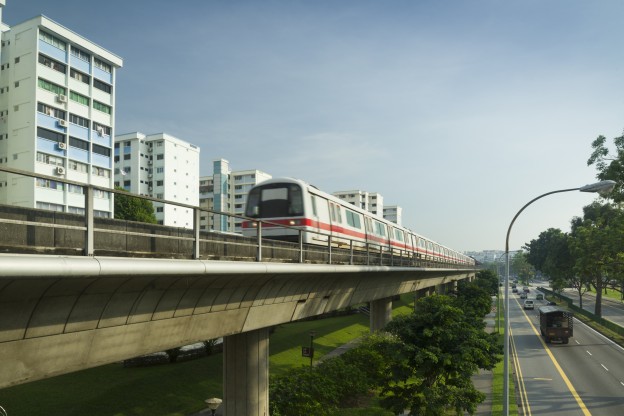A hot spring exists in Sembawang.

Although first discovered in 1908 by British soldier, William Arthur Bates Goodall, it was only in 1909 did the spring burst into the public conscious when it was rediscovered by Seah Eng Keong on his pineapple estate. Then, the spring was actually three springs that were channelled into one in order to concentrate the water conveniently in one area. As the spring’s fame spread, the nearby village came to adopt the name of Kampong Ayer Panas or ‘Village of Hot Water’.
Mr Seah had also sent samples of the water to Europe for testing which resulted in a 1909 article claim that the spring has valuable medicinal properties. This would prove to be appealing to the villagers and so Mr Seah did what any sensible businessman would in his situation; he bottled the water, gave it a brand – Zombun – and sold it.
Many years later, Fraser and Neave (F&N) would do the same. They acquired the site in 1922 and proceeded to set up a plant to harness the water and sell it under the brand name of Seletaris. In the future, after MINDEF acquired the land from them, F&N would develop a condo across the road from where the spring and army camp is and name it after their old brand of spring water.
People believe that the spring water can cure ailments like rheumatism, arthritis and heal skin problems such as psoriasis and acne. Doctors remain sceptical since there is no proof that the waters have any such healing properties. They do concede however, that the heat of the water can in fact, relax tense muscle and joints.

Taps installed to deliver spring water to the outside / Photo: CNA
But the hot spring is not for everyone as Mr Lai Soo Han discovered in 2002. Suffering from diabetes, he had wanted to use the water’s healing abilities only for the heat of the water to cause complications with his blood circulation. This resulted in blisters forming on his feet and the wounds turning gangrenous.
Mr Lai lost three toes on each foot as a result. After that, the Singapore General Hospital issued a warning to people that suffer from nerve disorders or diseases that affect blood circulation to steer clear of the hot spring. The spring’s fame also waned drastically and it has all but passed out of the public sphere.
In 1985, MINDEF acquired the land for military use but due to strong petitions from the public, MINDEF built a fence around the spring and opened it to the public from 7am to 7pm daily.
Plans throughout the 60s, 90s and even early 2000s to turn the area into a spa materialised only to evaporate as quickly as water on a hot day.
But hope that the spring will be part of something greater still flows. On April 16th 2016, a report confirmed that NParks was working with URA, SLA and MINDEF on turning the area into a park. It is still in the planning stages.
The hot spring now, unfortunately looks like a drain where people come to soak their feet or just lounge rather unceremoniously about. Around it are fences and concrete, with the army base in the horizon. The actual spring is locked up behind a brick house but piping and taps were installed on the outside to give people access to the water.
It’s certainly an uninspiring image for something that is more unique to Singapore than its army of modern buildings. Also, since it is opened to the public and only a mere caretaker employed by MINDEF to manage the place, all sorts of individuals show up at the site to either boil their eggs or wash their clothes.
Therein lies the problem with the hot spring. On one hand, something this precious should be treated better and made more well-known to locals but on the other hand, with popularity comes the burden of maintenance and over crowdedness.
The people that enjoy it now as a relaxing place will no longer find it to be so should the spring become a public hotspot visited by hundreds daily. And with more people, the place loses its prestige. The hot spring will cease to exist as a unique hotspot (pun intended) and instead become yet another common landmark for locals and tourists to visit.
Thus, one can understand why the authorities have found it difficult to execute any plans to do something with the area. The hot spring in Sembawang walks a truly fine line and is in danger of losing all that has made it special to the people that know and visit it.



